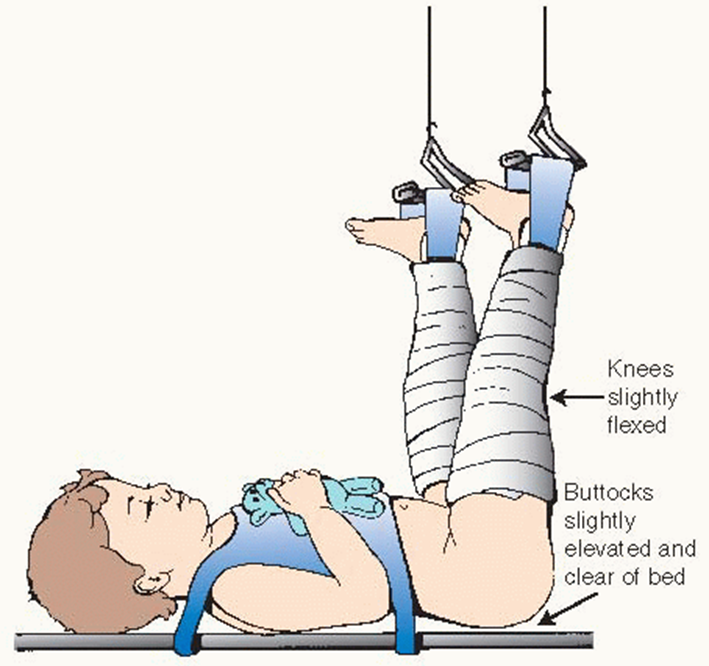A nurse is caring for a toddler who has a fractured right femur and is in Bryant traction. When determining that the traction is appropriately assembled, the nurse should observe which of the following?
Weights are attached to a pin that is inserted into the femur.
Skin straps maintain the leg in an extended position.
A padded sling is under the knee of the affected leg.
The buttocks is elevated slightly off of the bed.
The Correct Answer is D
Choice A reason: This is not a correct description of Bryant traction. This type of traction does not involve pins or wires inserted into the bone. It is a skin traction that uses adhesive straps or bandages attached to the skin of the lower legs.
Choice B reason: This is not a correct description of Bryant traction. This type of traction does not maintain the leg in an extended position. It flexes the hip and knee at a 90-degree angle and suspends the leg in the air.
Choice C reason: This is not a correct description of Bryant traction. This type of traction does not use a sling under the knee of the affected leg. It uses a spreader bar to keep the legs apart and prevent rotation.
Choice D reason: This is a correct description of Bryant traction. This type of traction elevates the buttocks slightly off of the bed to provide countertraction and alignment of the fractured bone.

Nursing Test Bank
Naxlex Comprehensive Predictor Exams
Related Questions
Correct Answer is C
Explanation
Choice A reason: Asking the parents what caused the bruises is not the best action, as it may not elicit truthful or accurate information. The parents may be the perpetrators of the abuse, or they may be unaware or in denial of the abuse. The nurse should not confront or accuse the parents without sufficient evidence or support.
Choice B reason: Notifying social services is an important action, but not the first one. The nurse should first gather more information and document the findings before making a report. The nurse should also follow the policies and procedures of the health care facility regarding child abuse reporting.
Choice C reason: Asking the toddler what caused the bruises is the best action, as it may provide valuable clues about the source and nature of the injuries. The nurse should use a gentle and nonjudgmental approach, and ask open-ended questions, such as "How did you get these bruises?" or "Who hurt you?" The nurse should also observe the child's behavior and body language, and reassure the child that they are not in trouble.
Choice D reason: Notifying the provider is a necessary action, but not the first one. The nurse should first assess and interview the child, and document the findings. The nurse should also consult with the provider about the appropriate medical care and follow-up for the child. The provider may also assist the nurse in making a report to social services.
Correct Answer is B
Explanation
Choice A reason: Changes in the voice signal the beginning of puberty is incorrect, as voice changes usually occur in the middle or late stages of puberty, not the beginning. The first sign of puberty in boys is usually testicular enlargement, followed by pubic hair growth and penile enlargement.
Choice B reason: Growth spurts in height occur toward the end of mid-puberty is correct, as this is the typical pattern of growth for boys during puberty. Boys usually start their growth spurt later than girls, but grow faster and for a longer period of time.
Choice C reason: Puberty might be delayed if scrotal changes have not occurred by the age of 11 years is incorrect, as this is not a definitive indicator of delayed puberty. Puberty can vary widely among individuals, and some boys may start later than others without any underlying problem. Delayed puberty is usually diagnosed if there is no sign of puberty by the age of 14 years.
Choice D reason: Gynecomastia commonly occurs during late puberty is incorrect, as gynecomastia, or the enlargement of breast tissue in males, usually occurs in the early or middle stages of puberty, not the late stage. It is caused by hormonal changes and usually resolves on its own within a few months or years.
Whether you are a student looking to ace your exams or a practicing nurse seeking to enhance your expertise , our nursing education contents will empower you with the confidence and competence to make a difference in the lives of patients and become a respected leader in the healthcare field.
Visit Naxlex, invest in your future and unlock endless possibilities with our unparalleled nursing education contents today
Report Wrong Answer on the Current Question
Do you disagree with the answer? If yes, what is your expected answer? Explain.
Kindly be descriptive with the issue you are facing.
